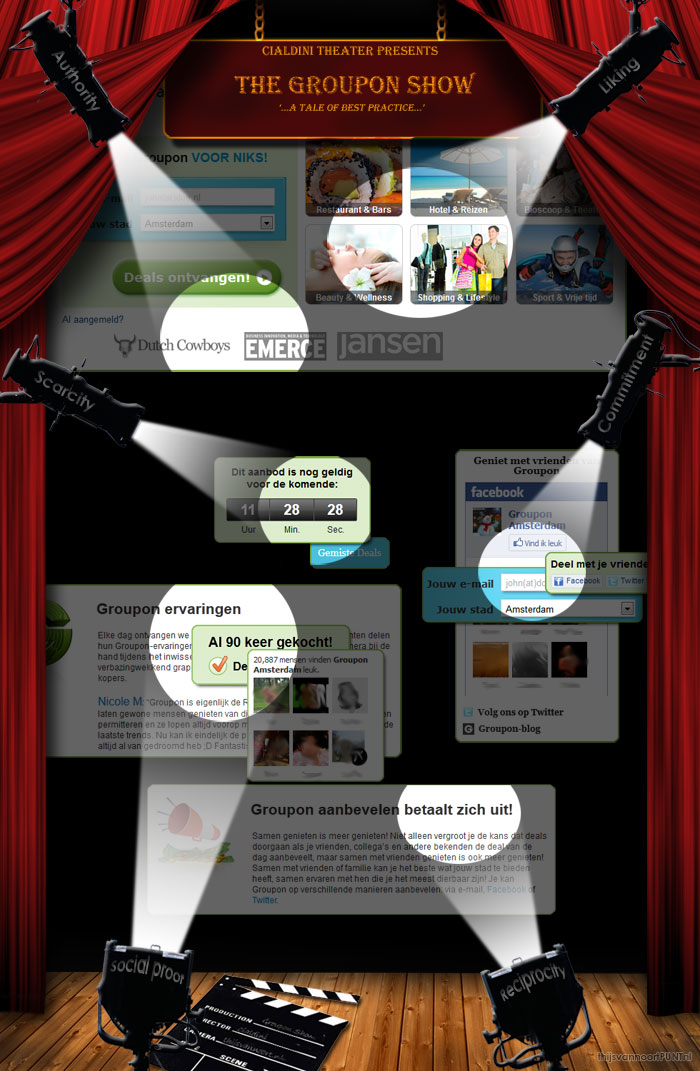Cialdini’s 6 principles of persuasion applied – Groupon (infographic)
In marketing the book Influence: The Psychology of Persuasion by Robert B. Cialdini has ever since its first publication in 1984 been known for the unique insights into the human brain that it provides. Whether these still apply today? Groupon proved it.
In the book, Cialdini zooms in on 6 triggers that are found in basically every human being and which, if triggered correctly, almost automatically lead to a fixed pattern of behaviour.
The 6 triggers pointed out by Cialdini
- Reciprocity
- Commitment and consistency
- Social proof
- Liking
- Authority
- Scarcity
And below infographic shows exactly how Groupon in the Netherlands successfully managed to apply each and every one of them.

Reciprocity
The concept of reciprocity is that when you offer something to someone else, the other is likely to feel obliged to give you something in return in the future. This ensures that the effort you go through isn’t for nothing.
What better example than the sentence (transl.) “Recommending Groupon pays off” to trigger reciprocity. A promise that your hard work will be rewarded.
Commitment and consistency
When it comes to commitment and consistency, the principle that applies is that it feels good to do what you said you would. This can be, among others, verbally, via the subscription with your email address or even with the Facebook Like button.
The integration of this social media widget is therefore a clever decision. Not only do people confirm to themselves that they like Groupon. Also to their social network. And once a liking is expressed, an individual will automatically feel a stronger need going forward to have another look or even… to make another purchase.
An additional benefit of the Like button exists. Besides the commitment by the person clicking Like her/himself, the people following that person experience sympathy for her/him. Depending on the level of sympathy experienced, odds are that the decision to ‘Like’ next spreads through the person’s network like wildfire.
Next to the direct use of Facebook widget, its presence serves another goal. It also creates social pressure. Not for a specific offer as such, but for the brand through the eyes of new visitors to the site, seeing the total likes received.
Social proof
When evaluating whether a decision is wrong or right, people often look at the world around them. The behaviour of others serves as social proof that certain behaviour is appropriate / acceptable or not appropriate / acceptable. In this example, the 90 others who purchased the offer before you.
Next to this, the Groupon Experiences component makes the offer even more socially accepted. The chosen testimonial makes it even easier to experience sympathy for this satisfied customer. Thanks to the recognizable perspective that life’s too expensive for ordinary people.
…let’s ordinary people enjoy the things that they normally wouldn’t be able to…
Liking
In general people like others who they identify with or want to identify with. The pictures that are part of the intro of the site, obviously show faces of people who have enjoyed the benefit of Groupon offers.
Instead of just promoting the company itself, pictures are used that have an obvious connection to the content.
And not just that. Even the direction in which the people on the pictures are looking (or pointing) plays an important role. As you can see, the attention of the lady with her bags is directed at the slogan and the call to action. Another driver for user behaviour. Whether you like it or not, You look where they look.
Authority
In the Netherlands we had a famous ad for Toilet Duck in the 80’s which simply said ‘We, the people at Toilet Duck, recommend Toilet Duck‘. By suggesting that they were simply the authority on making their product. Back then quite an effective slogan. However, the decision made in the Groupon scenario above is even more effective. By referring to all media outlets that have mentioned Groupon.
How much faster will you trust someone’s authority when even reliable other sources confirm it? These other sources being an authority in ‘all things internet and innovation’ only adds more weight to the argument.
Scarcity
The concept of scarcity is central to Groupon’s offering. The discount offered in combination with the time limit for its purchase, basically make up the definition of scarcity. An offer scarcely available in time.
The mere concept pushes people who prefer ‘to sleep on it’ to do so during their siesta.
In short, a limited opportunity to put the current purchase in the perspective of future purchases. Which has been proven to lead to people picking the option that offers most instant satisfaction.
Also the ‘Missed deals’ page further stimulates the perception of scarcity. Those deals are no longer part of your options. These missed opportunities in combination with the appeal of the current deals further stimulate making a purchase.
In summary, you can conclude that it seems like every piece of the Groupon site was chosen with a specific intent in mind. And then I haven’t even mentioned online marketing tools like copywriting, pagespeed, SEO and general name awareness.
Do you see other success factors in Groupon’s marketing? Help make this article an even more valuable resource and post them in the comments.
